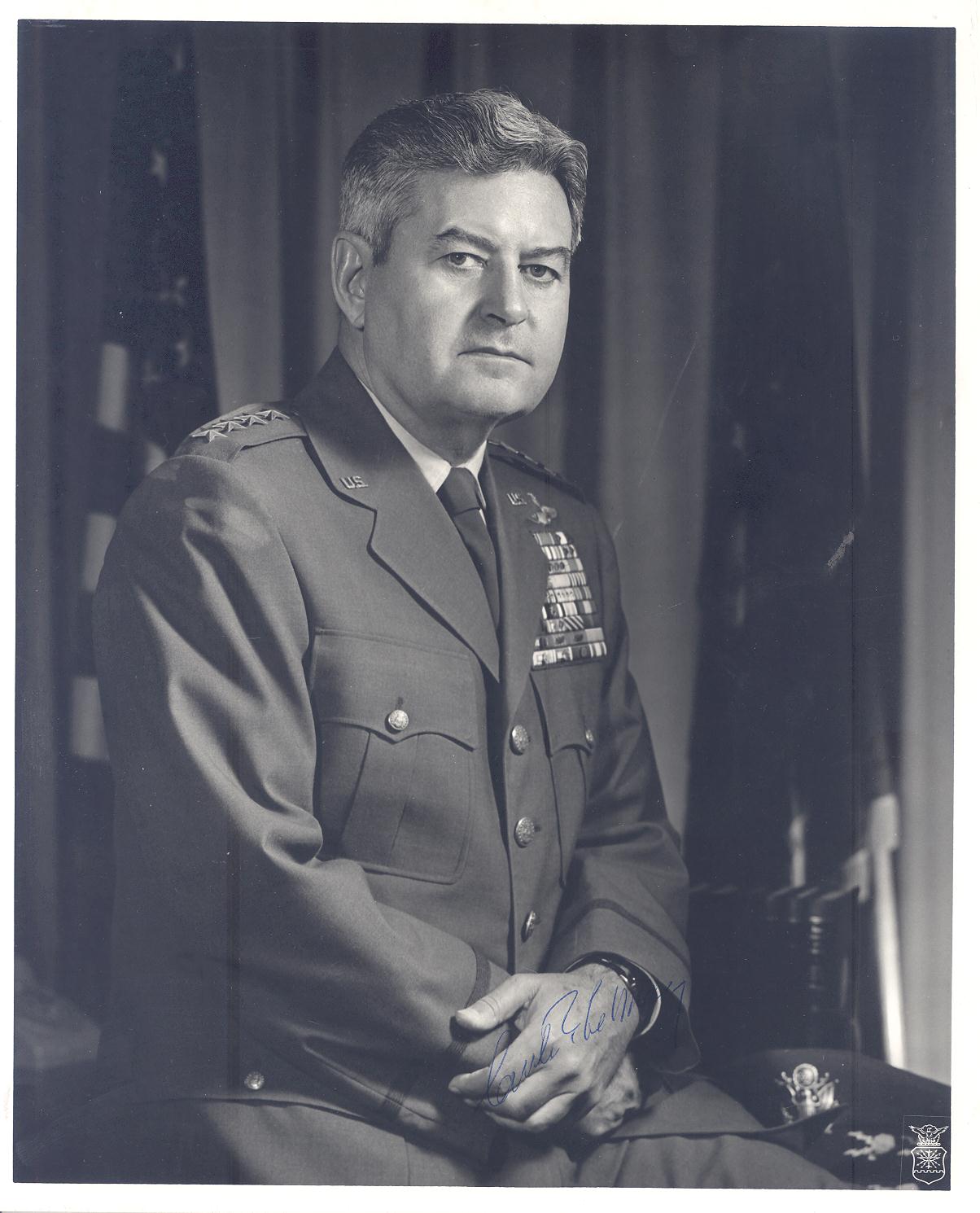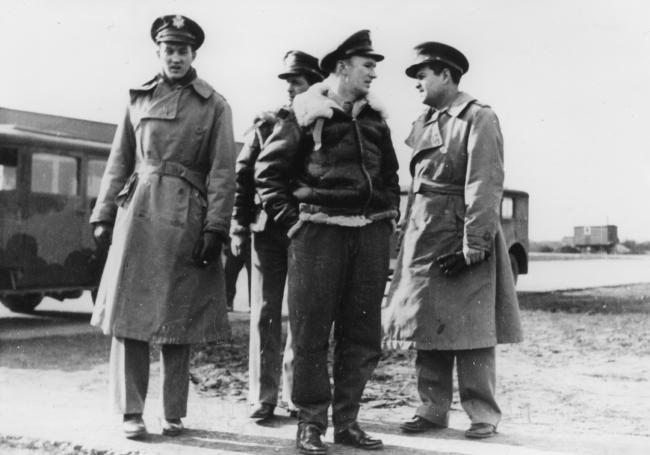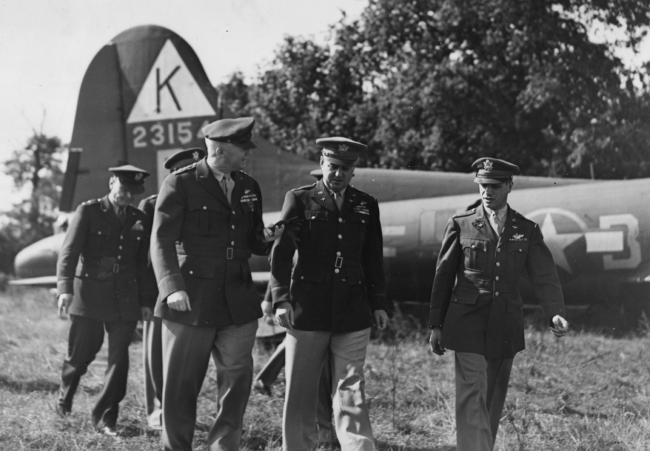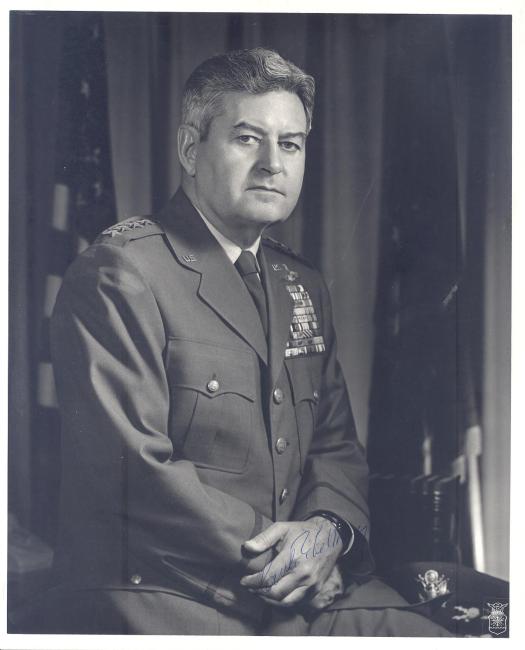Curtis Emerson LeMay
Military
Object Number - UPL 24757 - Signed photo of General Curtis E. LeMay, commander of the Bomb Division of the Eighth Air Force.
306th Temporary Deputy Commander at Wendover, then transferred as Group Commander of 305th BG 4-Jun-42 to 15-May-43.
Commanding General of the 3rd Air Division 13 September 1943 to 20 June 1944.
Post-war Commanding General SAC 16 October 1948 to 30 June 1957. 1961-1965 he was Air Force Chief of Staff. Retired 1 February 1965.
In 1928 Curtis LeMay joined the USAAC as a flying cadet. He was commissioned in 1929-30 as 2nd Lieutenant. In 1937 he was transferred to bombers. As Lt Colonel he led 305th Bombardment Group to England in 1942 as part of the 8th Air Force. He was well known for his development of defensive formations, such as the combat box, which was used to minimize aircraft losses in combat. These formations were used by B-17 bombers during missions over occupied Europe.
The following memories were recorded by the Daily Telegraph supplement, The Yanks, about his time in England…
“The brave boys based at Chelveston had more than their fair share of triumphs and tragedies during their 18 month stay in rural Northamptonshire. After flying several missions from Grafton Underwood, the first job facing the 305th Bomber Group (Heavy) was to perfect the best bombing height and formation to keep down losses.
Under Colonel Curtis LeMay, this was achieved with a staggered box formation and adopted successfully by all American squadrons throughout the 8th Air Force.”
As commander of the 4th Bombardment Wing, LeMay was promoted to Brigadier General in 1943 and transferred to 3rd Bomb division. Brave in combat, LeMay led several missions, notably the Schweinfurt-Regensburg raid in 1943 and later he led 146 B-17s to their target in Germany and on to bases in Africa.
In August 1944 he was transferred to the China-Burma-India theatre as leader of 21st Bomber Command. Believing that Japan’s manufacturing industry had to be destroyed if America were to launch a successful invasion of Japan, he supported fire raids which would destroy whole sections of cities associated with manufacturing. Always prepared to be controversial he is quoted as saying, “Killing Japanese didn’t bother me very much at the time…. I suppose if I had lost the war, I would have been tried as a war criminal….. every soldier thinks something of the moral aspects of what he is doing. But all war is immoral and if you let that bother you, you are not a good soldier.”
After the war, LeMay served in administrative positions before being assigned to command US Air Forces in Europe and organizing air operations for the Berlin Airlift. Later he returned to the United States to lead Strategic Air Command for nine years. LeMay began the process of adding intercontinental ballistic missiles as an element of the national nuclear arsenal.
He later became Chief of Staff for the US Air Force promoting the idea that strategic air campaigns were always the favored option. In the 1960’s he began to utilize satellite technology and maintained strong views regarding the use of missiles in Cuba and strategic bombing in Vietnam. His attitude was, “If you kill enough of them, they stop fighting………. All war is immoral and if you let that bother you, you’re not a good soldier.”
In February 1965, and unable to agree with government policy, LeMay retired from the USAF. He retired from public life in 1968 having failed to secure the necessary votes to run for vice-president.
Awards: DSC, DSM w/ 2 Oak Leaf Cluster, DFC w/ 2 Oak Leaf Cluster, SS, AM w/ 3 Oak Leaf Cluster, ADSM, NDSM, ACM, EAME w/ 3 stars, APCM w/ 4 stars, WWII VM, Army of Occupation Medal with the Berlin Airlift emblem, Medal for Human Action.
Connections
See how this entry relates to other items in the archive by exploring the connections below.
Units served with

- Unit Hierarchy: Group
- Air Force: Eighth Air Force
- Type Category: Bombardment

- Unit Hierarchy: Division
- Air Force: Eighth Air Force
- Type Category: Bombardment
People
- Military/Civilian/Mascot: Military
- Nationality: American
- Unit: 3rd Bomb Division 303rd Bomb Group 360th Bomb Squadron
- Service Numbers: O-430990
- Highest Rank: Lieutenant Colonel
- Role/Job: Pilot

- Military/Civilian/Mascot: Military
- Nationality: American
- Unit: 305th Bomb Group 381st Bomb Group 422nd Bomb Squadron 535th Bomb Squadron
- Service Numbers: 13030520 / O-437872
- Highest Rank: First Lieutenant
- Role/Job: Pilot, Co-Pilot
Aircraft

- Aircraft Type: B-17 Flying Fortress
- Nicknames: Silver Queen
- Unit: 92nd Bomb Group 95th Bomb Group 334th Bomb Squadron 335th Bomb Squadron
Places

- Site type: Airfield

- Site type: Airfield
- Known as: Grafton Undermud
Events
| Event | Location | Date | Description |
|---|---|---|---|
|
Born |
Columbus, Ohio | 15 November 1906 | Son of Erving Edwin and Arizona Dove [Carpenter] LeMay. |
|
Died |
March Field, Riverside County, California, USA | 1 October 1990 | (aged 83) |
|
Buried |
United States Air Force Academy Cemetery Colorado Springs, El Paso County, CO | 5 October 1990 | United States Air Force Academy Cemetery Colorado Springs, El Paso County, Colorado Plot Section 3, Row D, Grave 75 |
Revisions
Updated middle name and Died and Buried events per Find-a-grave Memorial ID 9654.
SOURCE: https://www.findagrave.com/memorial/9654/ctisur-emerson-lemay
Corrected a typo in the "Summary biography" - “utilize” was misspelled.
Daily Telegraph Supplement 1992 - The Yanks
Curtis LeMay - C N Trueman- historylearningsite.co.uk
militaryhistory.about.com -Kennedy Hickman
Curtis LeMay Quotes - webpage
Lee Cunningham 23-Nov-2014. Awards listed: from previous ingest information; CO 305BG dates: http://www.usaaf.com/8thaf/bomber/305bg.HTM
Drawn from the records of the National Museum of the Mighty Eighth Air Force, Savannah, Georgia / The Mighty Eighth by Roger Freeman; Combat Crews page 141;
![Brigadier-General Haywood S. Hansell (right) and Colonel Curtis E. LeMay (left) with a B-17 Flying Fortress nicknamed "Dry Martini and the Cocktail Kids the 4th" of the 305th Bomb Group, 13 May 1943. Official caption on image: "71088 A.C." Printed caption on reverse: '71088 USAF - Brig. General Haywood S. Hansell and Colonel Curtis E. LeMay pose beside the Boeing B-17 "Dry Martini 4th, The Cocktail Kids" on 13 May 1943. 304th[sic] Bomb Group based in England. U.S. Air Force Photo.'](https://assets.americanairmuseum.com/s3fs-public/styles/max_650x650/public/freeman/media-458106.jpg?itok=FuIwrMiC)
![Brigadier-General Curtis LeMay presents Lieutenant-Colonel Preston Piper of the 385th Bomb Group the Soldier's Medal for Gallantry. Image stamped on reverse; ‘Keystone Press.’ [stamp], ‘Passed for Publication [ilegible] Nov 1943.’ [stamp] and ‘292903.’ [Censor no.] Printed caption on reverse: 'PRESENTATION OF AWARDS TO THE HEROIC FLYERS OF THE EIGHTH AIR FORCE. So many American flyers of the Eighth Air Force here achieved many high distinctions that the presentation of medals and awards has be](https://assets.americanairmuseum.com/s3fs-public/styles/max_650x650/public/freeman/media-380180.jpg?itok=E1tBZd4Q)


![Colonel Curtis LeMay officially congratulates a bomber crew of the 306th Bomb Group in front of their B-17 Flying Fortress. Passed as censored 2 Jun 1943. Printed caption on reverse: 'One Flying Fortress Destroyed Eleven F.W.190's. O.P.S. On right, Col. Curtis LeMay, [censor struck out: a Combat Wing Commanding Officer] is seen congratulating members of the crew, they are, left to right; Sergeants Adrian, Buchanan, Warminski, Gray, Lieutenants Barberis, McCallum and Smith. 2/6/43. They shot these enemy pl](https://assets.americanairmuseum.com/s3fs-public/styles/max_650x650/public/freeman/media-407792.jpg?itok=jQkeX7P7)

![Brigadier General Curtis E Le May talks with Lieutenant Colonel Vandevanters and Colonel Castle of the 385th Bomb Group at a conference at Great Ashfield. Image stamped on reverse: 'Keystone Presss.' [stamp]. Handwritten caption on reverse: '10-11-43 Le May with pipe.'](https://assets.americanairmuseum.com/s3fs-public/styles/max_650x650/public/freeman/media-456607.jpg?itok=DJFJlH4k)
![Lieutenant Colonel Elliott Vandevanter of the 385th Bomb Group with Colonel Frederick W Castle of the 487th Bomb Group and Brigadier General Curtis A LeMay. Image stamped on reverse: 'Keystone Press.' [stamp], 'Passed for publication 13 Nov 1943.' [stamp] and '92902.' [censor no] Printed caption on reverse: '"BIG SHOTS" OF THE EIGHTH AIR FORCE. Photo shows: Lt Col Elliott Vandevanter Jr, Washington DC, youthful commander of a Flying Fortress group in England, col Frederick W Castle of Washington DC, and N](https://assets.americanairmuseum.com/s3fs-public/styles/max_650x650/public/freeman/media-456705.jpg?itok=80zRV4xs)



